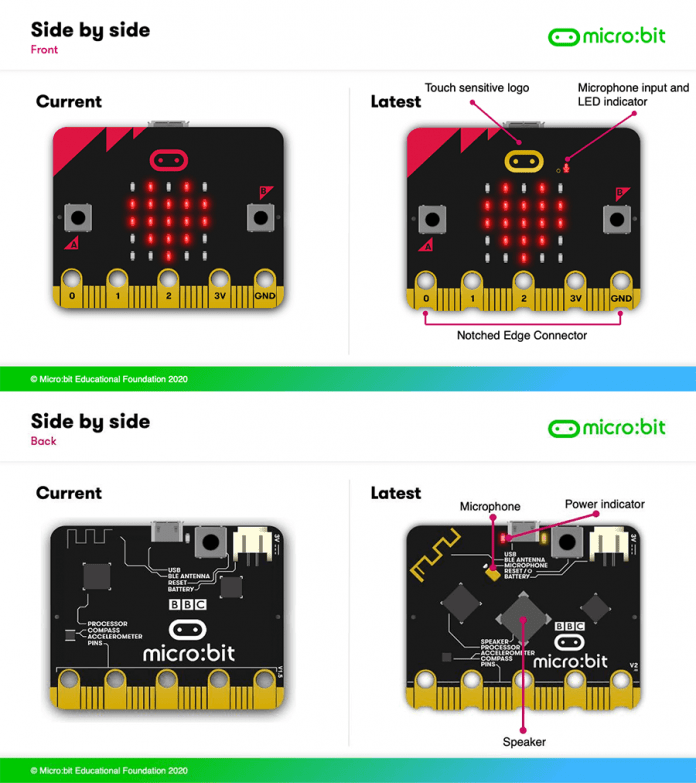The latest hardware in the Micro:bit world is that a new and improved version will soon be available to buy for the same low price as the v1.
In this article we will look at the new version and also compare the differences between the hardware.
First lets look at images of the Microbit version 1 and version 2 side by side
Micro:bit v2 image

Micro:bit v1 and v2 comparison
In the table below you can see a comparison between the version 1 and version 2 hardware
Description |
v1 |
v2 |
| Processor | Nordic Semiconductor nRF51822 | Nordic Semiconductor nRF52833 |
| Memory | 256kB Flash, 16kB RAM | 512kB Flash, 128kB RAM |
| Interface | NXP KL26Z, 16kB RAM | NXP KL27Z, 32kB RAM |
| Microphone | N/A | MEMS microphone and LED indicator |
| Speaker | N/A | On board speaker |
| Touch | N/A | touch sensitive logo pin |
| Connector | 25 Pin,3 dedicated GPIO, PWM, I2C, SPI and ext. power. 3 ring pins for connecting crocodile clips/banana plugs. | 25 Pin,4 dedicated GPIO, PWM, I2C, SPI and ext. power. 3 ring pins for connecting crocodile clips/banana plugs. Notched for easier connection. |
| I2C | Shared | Dedicated |
| Communications | 2.4Ghz Micro: bit Radio/BLE Bluetooth 4.0 | 2.4Ghz Micro: bit Radio/BLE Bluetooth 5.0 |
| Motion Sensor | ST LSM303 | ST LSM303 |
| Power Availability | 90mA available for accessories | 200mA available for accessories |
| Software Support | C++, Make Code, Python, Scratch | C++, Make Code, Python, Scratch |
| Power | 5V via Micro USB port, 3V via edge connector or battery pack. | 5V via Micro USB port, 3V via edge connector or battery pack. LED power indicator,Power off(push and hold power button) |
The latest version features a faster processor in the Nordic Semiconductor nRF52833 which works at about 4 times faster than the Nordic Semiconductor nRF51822 which is in the v1.
You get twice as much flash memory and an extra 112kB RAM
The communications are still Bluetooth but in the v2 they have been upgraded from Bluetooth 4 to Bluetooth 5
You now get a microphone, on board speaker and touch sensitive logo on the v2 as new features.
There is now 200mA available for accessories rather than 90mA and there is also a power indicator and a much needed power button.
Purchase
| Amazon.com | BBC Micro:bit V2.0 Board for Coding and Programming(Not Include Micro USB Cable and Battery Pack) |
| Aliexpress (Global) | Micro:bit V2 Development Board for DIY Projects |
Summary
As the board is the same size and has the same edge connector then all expansion boards that I have tried appear to work OK with the v2 hardware. The edge connector is notched to make it easier to connect.
Links
There are various ways you can develop for the Microbit
I have tried all of these, if you are a beginner to development or maybe not that interested then Scratch and Makecode would probably be your best options.
Arduino IDE works fine and there are a couple of Python editors like https://codewith.mu/ that work well and are easy to use
Looking at the Arduino core at https://github.com/sandeepmistry/arduino-nRF5 it appears that the Microbit v2 should hopefully work or at least be supported very quickly
Online python – https://python.microbit.org/v/2
Scratch – https://scratch.mit.edu/microbit
